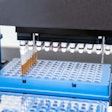
ANAHEIM, CA - Direct-to-consumer testing has great potential to get patients engaged about their health and to broaden access to medical information, but downsides include a lack of consistency in genetic reports and the risk for erroneous results, experts advised during a panel at the American Association for Clinical Chemistry (AACC) meeting on August 4.
The AACC meeting, being held August 4-8, featured the panel on consumer genomics, direct-to-consumer testing, and patient empowerment as a special session moderated by Minnesota Public Radio journalist Cathy Wurzer on the opening day.
Since the first direct-to-consumer companies were founded in 2010, consumer demand for tests has been rising rapidly, said Dr. Jill Hagenkord, who was formerly chief medical officer at 23andMe, Color Genomics, and Invitae, among other companies. The number of people tested by consumer genetics companies rose from 2.6 million in 2016 to 12 million in 2018, noted Hagenkord, who is now chief medical officer of a company she co-founded that provides medical diligence for health tech investors and entrepreneurs.
For labs, the direct-to-consumer trend has the potential to expand business, as it opens up the market of consumers who are not under the care of a physician, though they would need to be reached through large-scale advertising.
Hagenkord outlined the differences between tests overseen by the U.S. Food and Drug Administration (FDA) and laboratory-developed tests, which are regulated through the U.S. Centers for Medicare and Medicaid Services (CMS) CLIA program (see table). When consumers order tests through a website, a third-party lab handles the order. Companies need to make the consumer feel the testing is equal to what they would get through a health provider to get market adoption.
"From the consumer's perspective, these two paths look exactly the same, but from the regulatory perspective, one technically has been ordered by a physician and one has not been ordered by a physician," Hagenkord said.
| Comparison of regulatory frameworks | |
| Direct-to-consumer tests | CMS/CLIA lab-developed tests |
| Similar to over-the-counter authorizations | Regulated as a clinical laboratory |
| No licensed prescriber required | Licensed prescriber required |
| Regulated as a device manufacturing plant | Requires oversight by licensed, credentialed laboratory professionals and an appropriate quality management system |
| Requires premarket comprehension testing | Does not require premarket comprehension testing |
| Requires analytical validity and clinical validity | Requires analytical validity; does not require clinical validity (though for labs accredited by the College of American Pathologists, clinical validity is required) |
| Does not require clinical utility | Does not require clinical utility |
| Does not require genetic counseling | Does not require genetic counseling |
| Cannot be used in clinical decision-making | Can be used in clinical decision-making |
| At-home collection makes sample swap possible | At-home collection makes sample swap possible |
Putting consumers in the driver's seat
Advantages of direct-to-consumer testing include convenience and access, as tests may be ordered without needing to go through insurance companies, which sometimes impose high deductibles. Some studies suggest that when people know they have a higher cardiovascular risk based on their genetics, they are more likely to be compliant with statin therapy, Hagenkord noted. She said that she and her family members have gone through the process of genetic testing and have mapped out health conditions across the group using a smartphone app.
"I think that's a good signal," Hagenkord said. "There's some goodness there that we can focus on, amplify, and encourage."
But there are important limitations as well. The lack of completeness in reporting creates a risk for false negatives, and the level of completeness varies across labs, she noted. The penetrance and prevalence of genes and conditions are not known for low-risk, unselected populations, so the positive predictive value can't be calculated.
With next-generation sequencing, it's possible that something deemed "likely pathogenic" does cause disease, but there's also a chance that it is not pathogenic at all. Tests reporting pathogenic variants as positive have specificity of nearly 100%, but tests reporting variants as "likely pathogenic" have 90% to 95% specificity, Hagenkord explained. Furthermore, there may not be a confirmatory test or an intervention available to follow up on a lab result.
Since the penetrance is often extremely low, providers should manage asymptomatic people with positive results on an unselected genetic test with a "great deal of caution," she said.
A 'double-edged sword'
The direct-to-consumer approach is a "double-edged sword," according to panelist Dr. Theodora Ross, PhD, director of the cancer genetics program at the University of Texas Southwestern Medical Center.
In theory, awareness of one's genetic profile is valuable, but the accuracy of genetic testing is oversold; getting people engaged is great, but it needs to be done right, Ross suggested.
She provided examples from her own practice, such as a false negative on BRCA gene testing and a false positive for mutations associated with Lynch syndrome on a 23andMe test that had been a gift.
"Are we seeing false negatives?" Ross asked. "Of course we are."
A limitation of direct-to-consumer testing is that results can't be added to a patient's official medical record. But a downside of going through a health provider is that the process may be cumbersome and patients want information fast, Ross said. One question nowadays is whether clinicians and health providers are like taxis prior to the launch of Uber and other ride-sharing services -- that is, potentially dispensable middlemen.
When testing is done through a medical provider, clinicians may need to sort out discrepancies in results to make interpretations, and it takes time to figure it all out.
"Clinicians need to fill in that risk-benefit knowledge gap, but the patients have to come to us, we have to talk to them and see them -- and that's the problem," Ross added.
Hagenkord said that currently labs are doing "wildly different things." At one lab, a pathogenic result might be a false positive, while other labs have put together gene panels that are backed by a strong evidence base and offer clear follow-up. The panelists at the special session suggested that a simple system for rating lab tests would be helpful for informing not only consumers but also doctors and genetics counselors.
"There isn't a one-size-fits-all answer to this," Hagenkord said.
Ross said her advice is that consumers seek help from a healthcare provider to navigate the world of genetic testing.
Data privacy is also a concern for direct-to-consumer tests, as there are risks that personal information may be sold or stolen. In 2018, 23andMe inked a deal with GlaxoSmithKline to use information from its millions of users to inform the development of new drugs. Hagenkord said that issues related to data sharing could be managed through clear communication and consent agreements: When consumers are asked if they want to opt in for their data to be used on an anonymous basis for research, almost everyone says yes.
"Nothing's perfect," Hagenkord said. "As long as people are consented and are aware of the risks."



















